Large and in Charge
Elephantidae
by Inspector Barry Mins on December 6, 2022Hey kids, welcome back to our series on the mysteries of created kinds. Last week, we met some very pretty waterfowl. This week, we go from birds to mammals, and upsize body mass significantly. These mammals are some of the largest animals in the world.

This kind has a very small representation, with only three species. However, it has multiple extinct members, including one that is just as famous as its living relatives. Surviving members of this kind are found across Africa and central Asia and live in family groups led by a female matriarch. Matriarchal status is largely determined by age.1 Males live on their own, only coming to the herds to breed. Males will fight each other for access to the females. Females take years to reach maturity, with the mean age of first giving birth being 14 years.2 The gestation period is also intensely long—22 months.3
These massive beasts need lots of food to survive. During the dry season, they will munch on woody plants, but in the wet season, they prefer leafy greens.4 They can use their heavy tusks and massive bulk to knock over trees and shrubs to reach the leaves at the top. These tusks are made of ivory which makes them popular with poachers. Illegal hunting has put a strain on their populations.
Has anyone figured it out yet? This week’s kind is the Elephantidae—the elephants. Many of you have doubtless seen elephants in the zoo. You may even have ridden one! Stay tuned for next week when we start looking for a group of moderately small mammals.

Asian Elephants, Ad Meskens via Wikimedia Commons
Try out this Elephant Connect the Dots or watch a video of Elephants!
Clue
Your clue for the week is:
These mammals get their name from their scent glands, which can produce a very unpleasant odor . . . but they are not skunks.
Ask a Question
Have you ever had a question about created kinds but didn’t know who to ask? Have you ever wanted to learn more about your favorite kind? Well, now you can! You can ask me, Inspector Barry Mins, a question! Have your parents help you fill out this form, and you might get your question answered in my column! If you have any questions about created kinds, feel free to send them my way!
Footnotes
- G. Wittemyer and W. M. Getz, “Hierarchical dominance structure and social organization in African elephants, Loxodonta africana,” Animal Behaviour 73, no. 4 (April 2007): 671–681.
- C. J. Moss, “The demography of an African elephant (Loxodonta africana) population in Amboseli, Kenya,” Journal of Zoology 255, no. 2 (February 2006): 145–156.
- T. B. Hildebrandt, F. Göritz, R. Hermes, C. Reid, M. Dehnhard, and J. L. Brown, “Aspects of the reproductive biology and breeding management of Asian and African elephants Elephas maximus and Loxodonta africana,” International Zoo Yearbook 40, no. 1 (June 2006): 20–40.
- N. Owen-Smith and J. Chafota, “Selective feeding by a megaherbivore, the African elephant (Loxodonta africana),” Journal of Mammalogy 93, no. 3 (June 2012): 698–705.
- © 2024 Answers in Genesis
- Privacy Policy
- Contact
- About
